Spain
| Mallorca | Barcelona |
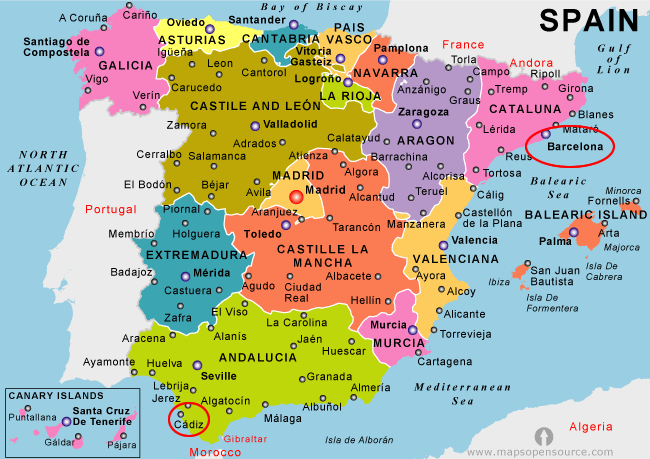
Although I did not plan to include much about Spain itself, some of this history, especially about the Golden Age of Spain under the Moors is fascinating. Sorry, no pictures...
Spain
Some of the lectures, both by the ship’s lecturer and our lecture have focused on Moorish Spain. It was the Berbers of Northern Africa who in 711 first crossed the Straits of Gibraltar to start the conquest of Spain. As a prelude to this, starting in the middle 600s, in a short 60 years, financed by trade, Islam spread across Northern Africa and much of what we now call the Middle East, plus land including many of the “Stans.”
During this time the Byzantine Empire, headquartered in Constantinople and the Holy Roman Empire had become very weakened by their battles with each other. Additionally, the Spanish were not very happy with the Visigoths who had succeeded the Romans, resulting in the conquest of all but Andalusia (which was never conquered) in eight years.
The Islam that crossed the straits was very moderate. They drank, and awarded women equal status. It was the Byzantines who started the custom of veiling women. Islam at that time had no restrictions on women. Mohammed wrote, “I will not suffer to be lost any work, no matter who creates it.” Women in his age had no restrictions on their movements. Given that any religion takes on the customs of the society in which it is introduced, probably when Islam arrived in the Byzantine Empire, they introduced the idea of marginalizing women.
After the conquest, the Caliphate of Umayyad was declared, headquartered in Cordoba. Events in Bagdad had an effect on Spain. There in 750 AD, the Abassids overthrew the Umayyad Dynasty. An exiled Umayyad prince, however, escaped to Spain and seized power in Cordoba, proclaiming himself Emir. Following the custom of Bagdad in that period Houses of Wisdom in Cordoba were introduced. In these meeting places extremely intelligent and talented people gathered to exchange ideas, creating the Golden Age of Spain.
Córdoba, the capital of the caliphate since Abd-ar-Rahman III, was the largest, richest, and most sophisticated city in western Europe. Mediterranean trade and cultural exchange flourished. Muslims imported a rich intellectual tradition from the Middle East and North Africa resulting in an important part in reviving and expanding classical Greek learning in Western Europe.
This was a period which has been referred to as “La Convencia,” which ended in 1148. In this period Jews and Christians lived together relatively harmoniously. The only requirement was that members of religions other than Islam, pay a small tax to Islam. Although not exactly first class citizens, the peoples of other religions were free to practice their religion and often had high positions. For the Jews this was a great improvement over their treatment by the Byzantines resulting in immigration of other Jews from both Europe and other Arab territories.
The Golden Age of Spain lasted about 300 years. It was through the Moors, that Greek philosophy revived in Western Europe. “Inventions,” such as paper, created in China, were introduced by the Moors. They derived this knowledge from a Chinese prisoner who had the recipe. The Moors, however, improved on paper, by experimenting and found that it could be made from bark other than that of the Mulberry tree, and from rags. In 953 AD they invented the fountain pen. Progress was also made in surgery, anesthesia, pharmacology, botany, and geography including cartography. Ibn Baytar, a pharmacist, introduced the scientific method, and introduced 400 new drugs.
The city of Cordoba had a library of over 30,000 books, all of which were burned when the Catholics reconquered Spain, a process called the Reconquista, which started in Andalusia, the one province that held out against the Moors. The Romanised cultures of the Iberian Peninsula interacted with Muslim and Jewish cultures in complex ways, giving the region a distinctive culture.
Outside the cities, where the vast majority lived, the land ownership system from Roman times remained largely intact because Muslim leaders rarely dispossessed landowners and the introduction of new crops such as citrus fruits and eggplant, as well as better agricultural techniques led to an expansion of agriculture. During this Golden Age, a man was judged on the basis of literacy skills as much as his social qualities.
In the 11th century, the Muslim holdings fractured into rival Taifa kingdoms, allowing the small Christian states the opportunity to greatly enlarge their territories. The arrival from North Africa of the Islamic ruling sects of the Almoravids and the Almohads restored unity upon the Muslim holdings,but with a fundamentalist, less tolerant application of Islam such as the prohibition of allcohol and other forbidden pleasures. These re-united Islamic states experienced more than a century of successes that partially reversed Christian gains. The Moors were finally expelled in 1492 by the Decree of Andalusia, which gave permission for the Islamists to keep there religion, a practice that lasted less than 30 years as the Spanish Inquisition took hold.
Since the overthrow of Franco, Spain has been a parliamentary, constitutional monarchy. Spain today has a very high unemployment rate, especially for the youth; being 50% for this age group in one city which, if I remember correctly, is Barcelona. As a result, we were warned about pickpockets, and other attempts to relieve us of our possessions. Despite this unemployment, Spain has the 14th largest economy by GDP, and 16th largest in purchasing power.
Palma de Majorca - April 11
Mallorca is the most populous and largest of the five Spanish Balearic Islands. Like the other Balearic Islands of Minorca, Ibiza and Formentera, the island is an extremely popular holiday destination, particularly for tourists from Germany and the United Kingdom.
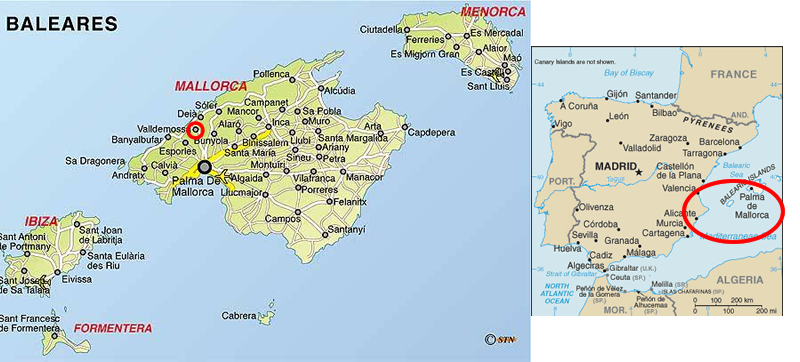
It is the capital of the autonomous Balearic Islands. which have been autonomous from Spain since 1983. Its capital is Palma de Majorca which is where we moored. Or I should say, Palma is near where we were moored. Unfortunately, we were moored a long ways from the city of Palma and I did not get to again walk the streets. We were here in 1996 for the wedding of the daughter of good friends and I was really looking forward to again doing that.
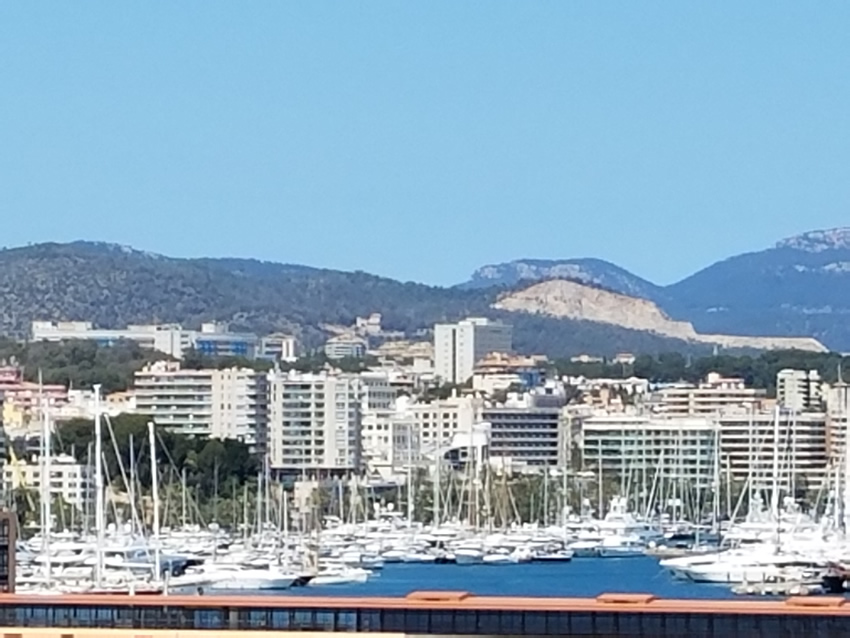
This is a picture of a small part of Palma showing part of the marina. The street that runs along the bay is now mostly restaurants for the tourists and boat owners.
Like all these islands and Mediterranean lands, its history dates back forever… Archaeologists have found burial chambers and traces of habitation from the Neolithic period (6000–4000 BC). The first to colonize the island were the Phoenicians, a seafaring people from the Levant, who arrived around the 8th century BC and established numerous colonies. The island eventually came under the control of Carthage in North Africa, which had become the principal Phoenician city. After the Second Punic War, Carthage lost all of its overseas possessions.
The island was occupied by the Romans in 123 BC under Quintus Caecilius Metellus Balearicus. It flourished under Roman rule, during which time the towns of Pollentia (Alcúdia), and Palmaria (Palma) were founded. The local economy was largely driven by olive cultivation, viticulture, and salt mining. Majorcan soldiers were valued within the Roman legions for their skill with the sling.
There is an interesting story told about the inhabitants about the time of Roman Conquest. Their slingshot skill was developed from childhood when children could not get supper until they had hit a number of objects with their sling shots. When the first Roman ships arrived, in the harbor, the Marorcans fired their rocks, putting holes in the Roman Galleys repulsing the attack. However, they returned again, but this time they had put skins around the galleys so that the rocks could not penetrate.
In 902 AD, the Moor Islam al-Khawlaní conquered the Balearic Islands, ushering in a new period of prosperity under the Emirate of Córdoba, then the ruler of most of Spain. The town of Palma was reshaped and expanded. Later on, with the Caliphate of Córdoba at its height, the Moors improved agriculture with irrigation and developed local industries.
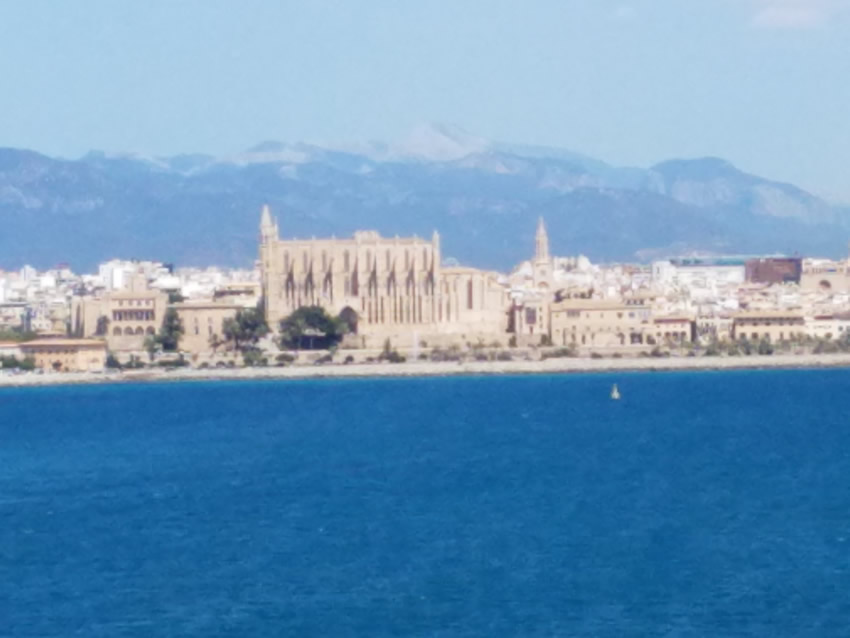
The above cathedral is in Palma, and can be seen by ships entering the harbor. It was built between 1229 and 1346. It is the third largest cathedral in Europe. Below is a better picture of the cathedral and a picture of Belllver Castle stolen from Wikipedia's Palma page.
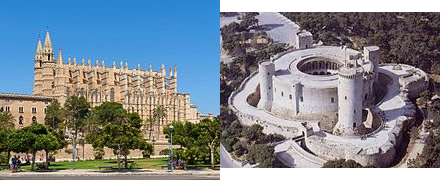
This island too, has a water problem. Drinking water has become a rare commodity on Majorca because of the increasing number of hotels and golf courses, that are irrigated daily. The groundwater level has sunken with effects on vegetation and climate as well as an intrusion of salt water. During the summer months drinking water has to be shipped in by tankers from continental Spain. Desalination plants are rare due to their expense and high consumption of electricity. Our guide never mentioned cisterns to collect what rain water there is, and we did not see any.
To make it worse, many sites lack sufficient sewage treatment and wastewater pollutes the Mediterranean Sea. Abnormal green algae populations are found, and are indicators of nutrient pollution. The dying bay of Santa Ponsa is an example of this pollution.
In 1229, King James I of Aragon captured Majorca from the Moors, who never really controlled it, and annexed it to his Crown of Aragon where it remained. During the civil war (1936-1939) an attempt was made to drive the Nationalists out and reclaim the island for the monarchy with an amphibious landing, but Nationalist air power from Fascist Italy stopped that and in 1936 the Italians occupied the island. We did not hear any more about WW II here; I suspect that it was not strategic, and left pretty much alone.
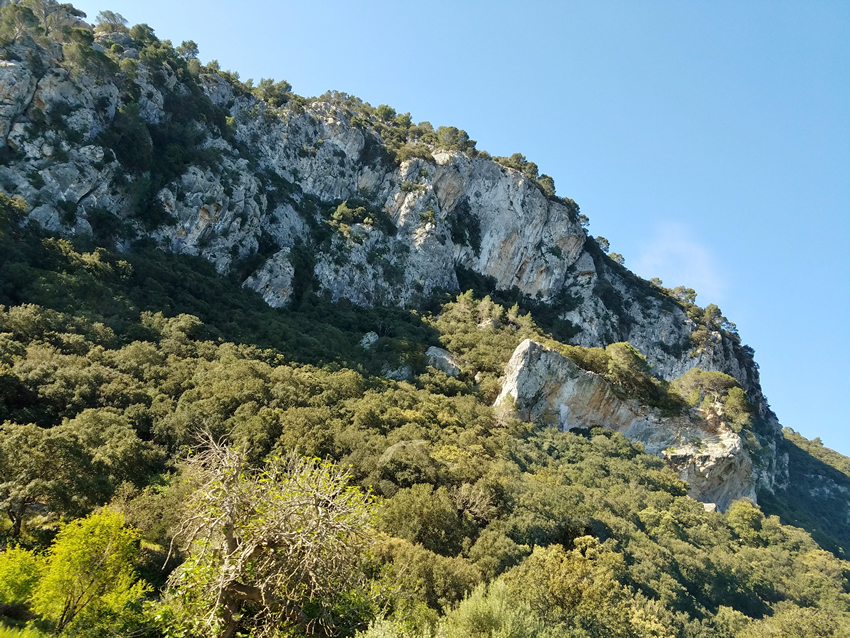
This is one example of the mountains on Majorca.
Majorca has two mountainous regions, the Serra de Tramuntana and Serres de Llevant. Each are about 43 mi in length and occupy the north-western and eastern parts of the island respectively. The highest peak on Majorca is Puig Major, 4,741 feet high, in the Serra de Tramuntana. The northern coast is rugged and has many cliffs. The central zone, extending from Palma, is a generally flat, fertile plain known as Es Pla.
The island has a variety of caves both above and below sea - two of the caves, also contain underground lakes and are open to tours. We did not see either of these.

This is a view from the Monastery in Valldemossa.
We spent our time in Valldemossa in the Sierra de Tramuntana Mountains visiting La Cartuja, a Carthusian Monastery, originally built as a royal palace, but transformed to a monastery in 1399. In this monastery, the monks maintained complete silence, except for one half hour on Thursday afternoon when they might talk with one another in the library. They lived in individual cells, slept on boards, and had no human contact the rest of the week. Meals were delivered in a double cabinet so they could not interact with the person bringing them. The monks were allowed to take 3 books from the library to their cells.
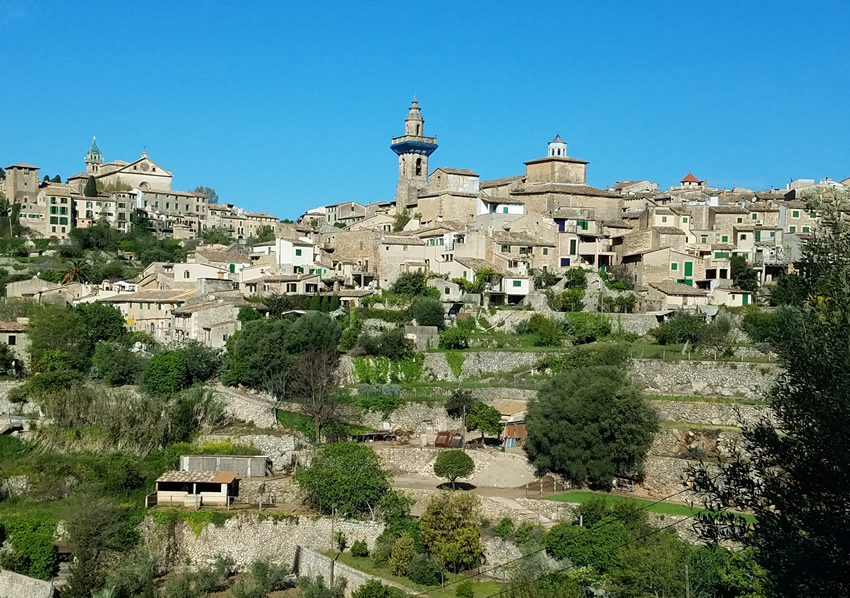
A view of Valledemossa taken as we approached.
Right next door to the former monastery is the house where George Sands and Chopin spent 2 months in 1838-39. Chopin was there because he was suffering from TB and his son from asthma. The belief was that it would be better weather there than in northern Europe. Unfortunately, that winter was one of the worst ever experienced on Majora, and was not pleasant for him. While here he lived with George Sands, which thoroughly upset the townfolk, plus George smoked, and had the audacity to wear pants! The town folk were very hostile to her and she wrote a scathing account of them.
Before the couple arrived here they had ordered a piano from Paris. However, it did not arrive with or before them. They finally found a piano of sorts and Chopin was able to do some composing here. The piano they bought in Paris arrived 10 days before they left permanently. It was left here because it was too expensive to take home with them and it remained here. No one wanted it because a man with TB had used it. Actually that made a lot of sense because the TB bacillus can hole up and live for years without human contact.

A street in Valledomasa. All the streets had little cafes. I stopped and had a cafe con leche - something that I had been looking forward to!
The Chopin museum has some photocopies of his original compositions while there. And some pictures of George Sands, and the one photograph of Chopin. We were treated to a concert while there which was beautiful.
I feel like I did not get to visit the island because I know of so many places that we did not see – on most of the other islands I was not aware of how much we missed. However, we made up for it as we left the port. We sailed along the SW corner of the island and were treated to beautiful cliff views. I am sorry that I did not have my camera, but the light was not right for pictures.
Barcelona April 12 & 13
Barcelona, which was founded in the Middle Ages, is the capital city of the autonomous community of Catalonia. It is the largest city on the Mediterranean. As we sailed into the harbor I was surprised to see a high hill on one side (the only side that I could see!) with a fort at the top.
The port here is VERY busy. At dinner one evening I watched 5 passenger ferry boats come in – and they were quite large. There is also another cruise ship in the harbor with us – and it is HUGE.
In its day, Barcelona has been at times a Roman retirement colony, a maritime power, a dynamo of the Industrial Age and an urban poster child for modernism. Today it combines all these elements into a one-of-a-kind culture. (The Plain Dealer | Page K04 Sunday, 14 August 2016)

This is Easter Week and with school out it is a very busy city. I was lucky enough to have a tour of the inside of the Sagrada Familia Basilica, the famous church built by Gaudi. One has to make a reservation months in advance to secure these. Walking towards it, we rounded a corner, and there was part of it. I shook my head – it is just, well, too much. The word ornate does not do it justice. Below is only a very small portion of the Basilica.

The inside is also beyond words. Stained glass windows, each bank a different color, pillars to the ceiling, all are a part of the effect. Each item, inside as well as outside, is a symbol of something religious.

This article below from the newspaper describes it well. “Sagrada Familia (Holy Family Church) is Gaudi's unfinished masterpiece. It boasts bold, organic architecture and decor inside and out — from its melting Glory Facade to its skull-like Passion Facade to its rainforest-esque interior. Gaudi labored on the Sagrada Familia for 43 years, from 1883 until his death in 1926. Since then, construction has moved forward in fits and starts. In 2010, the main nave was finished enough to host a consecration Mass by the pope. As I (the author of the piece) stepped inside on my last visit, the brilliance of Gaudi's vision made for lofty worship in the nearly completed nave. (The Plain Dealer | Page K04 Sunday, 14 August 2016).
At age 74, Gaudi, in perfect health, was hit by a tram and died, with many of the plans still in his brain.
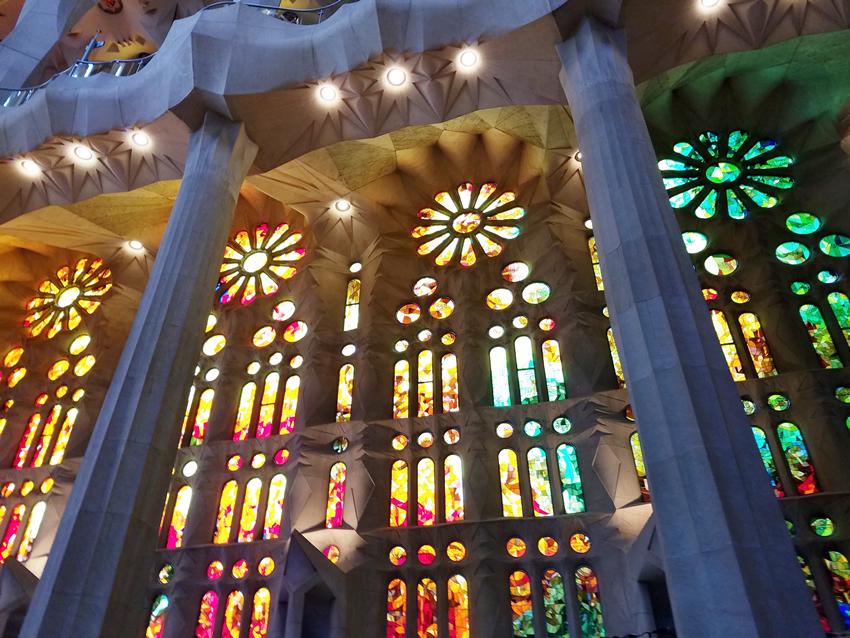
Consequently, other artist/architects have labored to decide what he wanted. Then, during the Spanish Revolution, anarchists destroyed all the plaster models compromising the plans for the church.
Park Gŭell, another Gaudi creation, was to be a planned community for well-heeled residents. It was commissioned by Eusebi Gŭell, on a large property that he had acquired. It is located on a mountain with great views of the sea and the Plain of Barcelona. The plan included provisions for 60 triangular plots with a complex network of paths, viaducts, and steps to accommodate the steep topography.
There were many restrictions on a house here, such as only one side of the plot could be built on and the houses were to be only for residences. Construction of the park began in 1900. However, the restrictions on the plots, its exclusive nature, and no proper transportation resulted in only three houses being built. By 1914 work ceased and in 1922 Gŭell’s heirs offered it to the city of Barcelona which opened it as a public park in 1926.
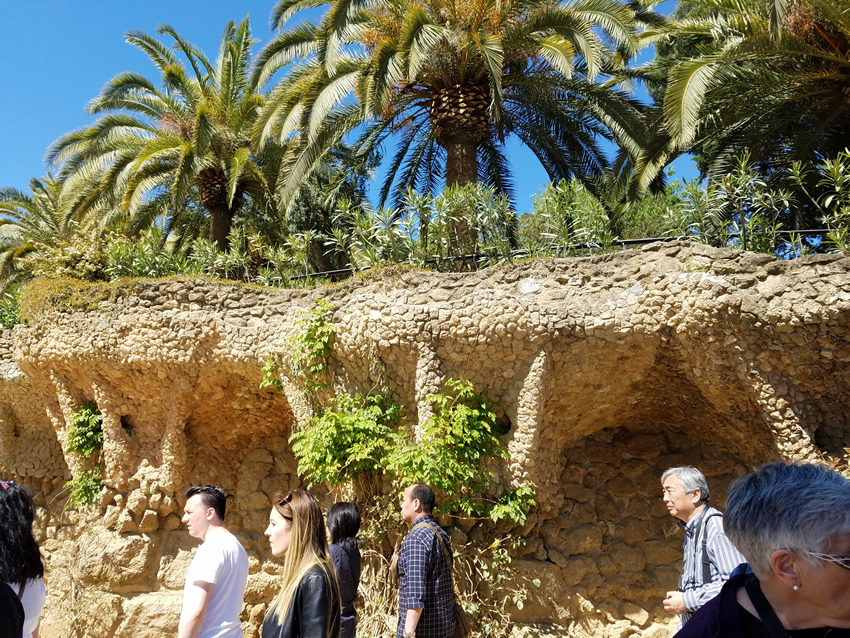
Above is the picture of one of the viaducts supported by palm tree pillars.
It is a hard place to describe. The various viaducts and other objects are supported by pillars in the shape of palm tree trunks. The plaza, which has views of the city, is lined with benches made of broken pottery, Surprisingly, despite bumps along the bench, it is very comfortable. Under this plaza it a concrete floor with support from surprisingly rather plain pillars that was going to be a market. The ceiling even here has some beautiful designs. Like the Sagrada Familia it is pure Gaudi, as in a little over the top.
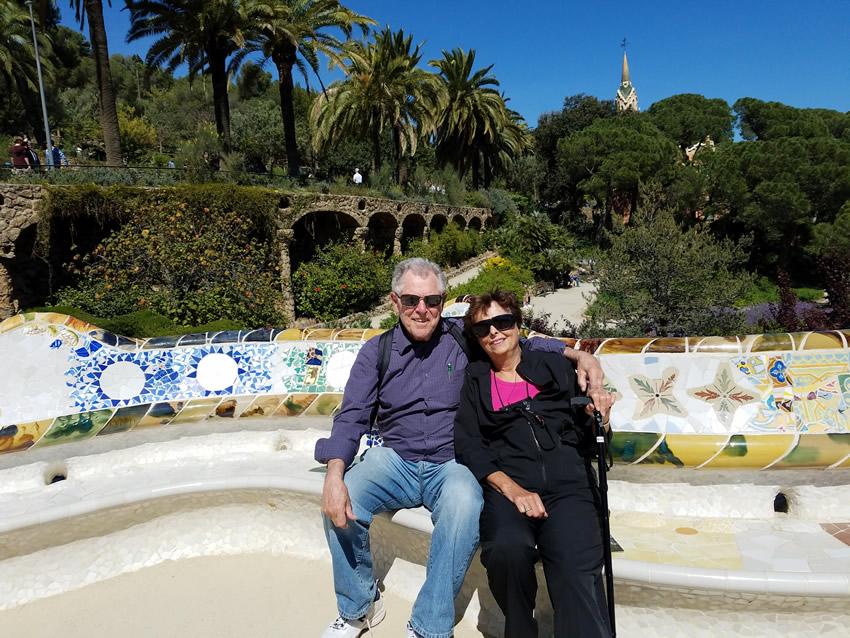
Above is the park bench with LQT and another tourist.
There is a cable car to the top of Montjuic which four of us took advantage of, both for the views at the top and on the ride up. See the rest of the motley crew below.

At the top we enjoyed a cup of café con leche and the view at the café at the top of the cable car. Then the other woman and I meandered around up there and finally took a taxi back down to avoid what looked like more than an hour’s wait to re-board the cable car. Our weather in Barcelona has been beautiful, sunny, and low 70’s with enough breeze to make it very pleasant.
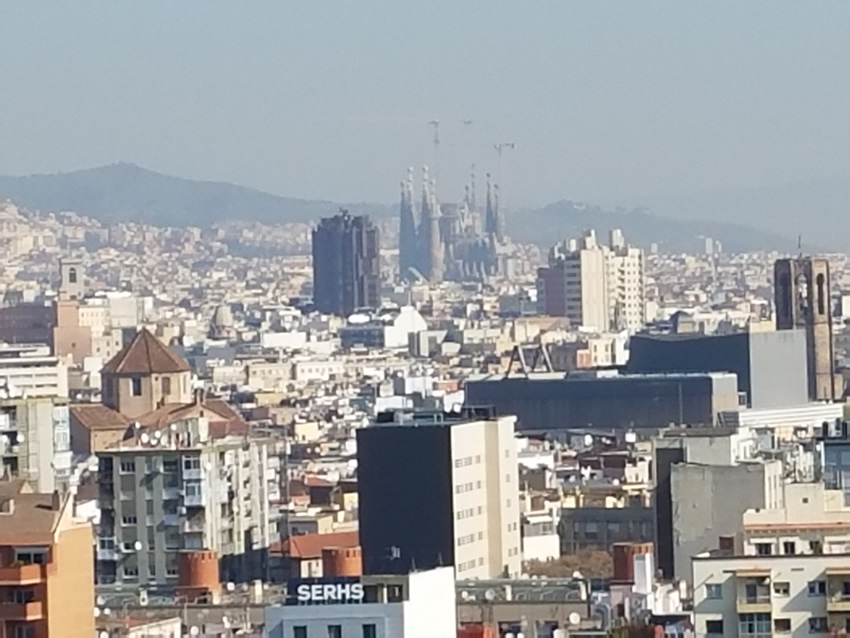
View from Monjuic. Note the Sagrada Familia Basilica in the distance (the four big spires).
From where our ship was moored we could see many sailboats sailing on the Blue Mediterranean. I could even see what looked like a sailboat race going on, but from my view I could not tell which boats were in the lead and which were bringing up the rear. Suffice it to say that Barcelona is a gorgeous, cultural, and artistic spot. It is bordered by mountains to the West and is not short of hills itself!
Cadiz April 16
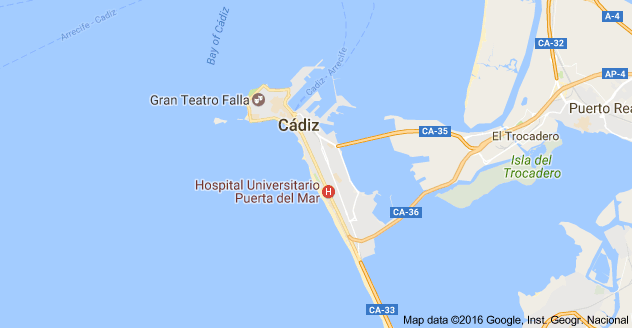
A fog delayed our entry into Cadiz making all the tours about one and a half hours late. This is one that I sat out. Our tour was going to Seville, an hour and a half away. I have been there and I choose a day of rest to get ready for Casablanca the next day.
Cádiz, however, is worth a visit on its own. It is the oldest continuously inhabited city in Spain, and one of the oldest in western Europe, and has been a principal home port of the Spanish Navy since the accession of the Spanish Bourbons in the 18th century. Below is one of the views from the deck.
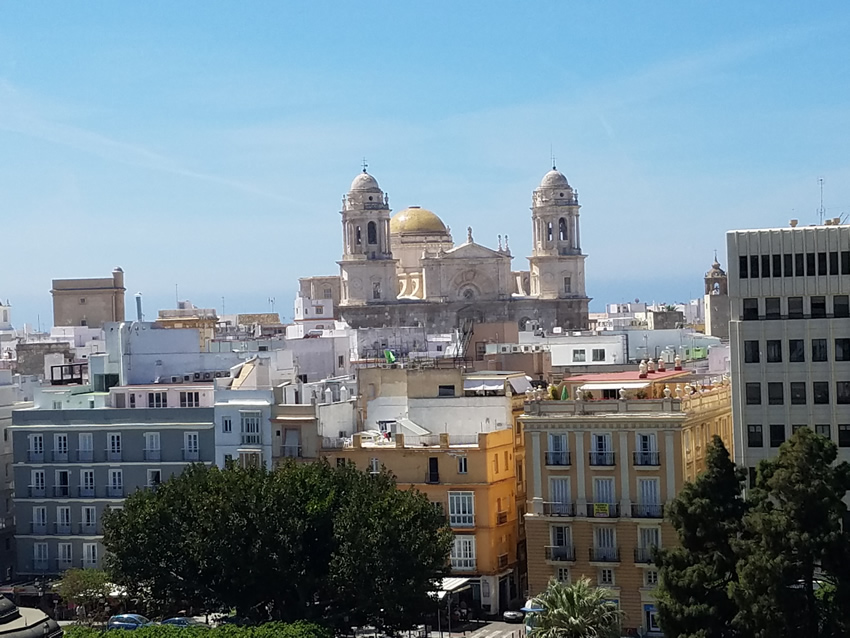
Cadiz rests on a narrow slice of land surrounded by the sea. It is, in most respects, a typically Andalusian city with a wealth of attractive vistas and well-preserved historical landmarks. The older part of Cádiz within the remnants of the city walls is commonly referred to as the Old Town (Spanish: Casco Antigua). It is characterized by the antiquity of its various quarters (barrios) which present a marked contrast to the newer areas of town. . In addition, the city is dotted with numerous parks where exotic plants flourish, including giant trees "supposedly" brought to Spain by Columbus from the New World.
